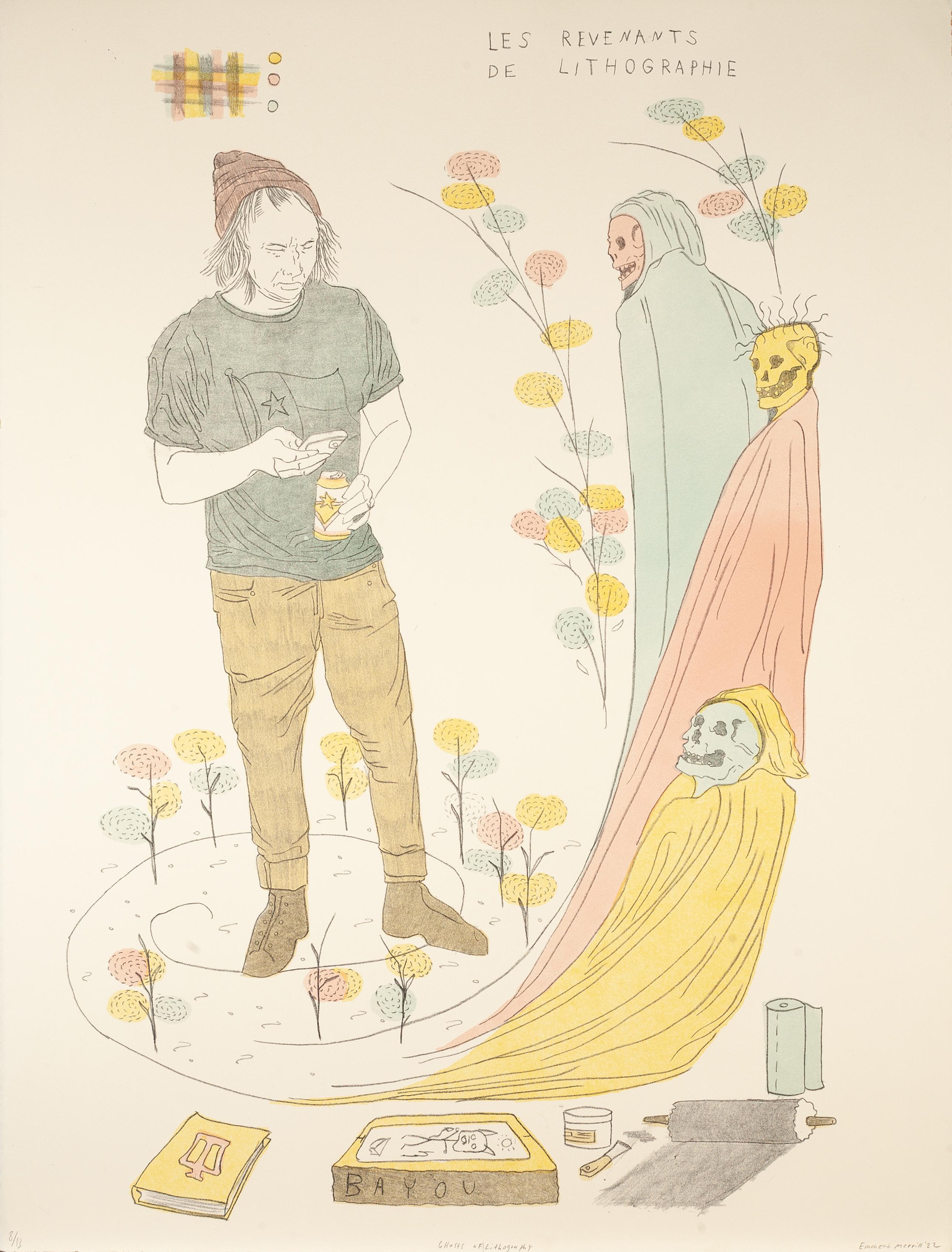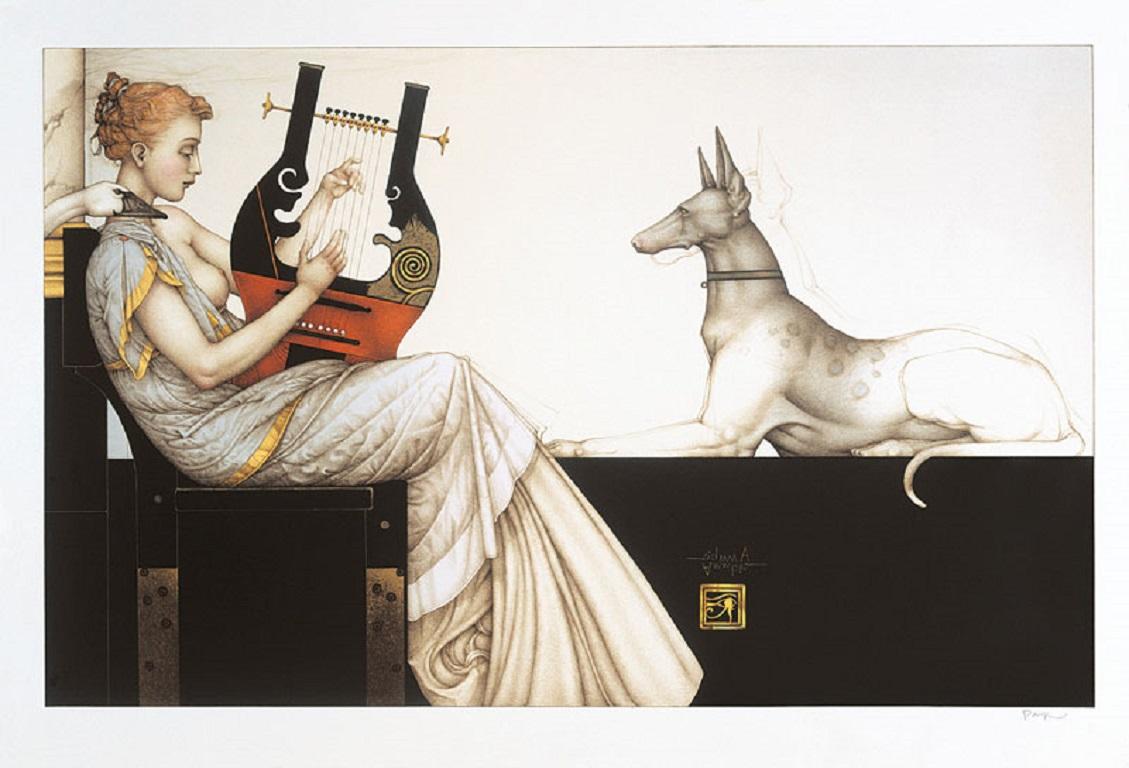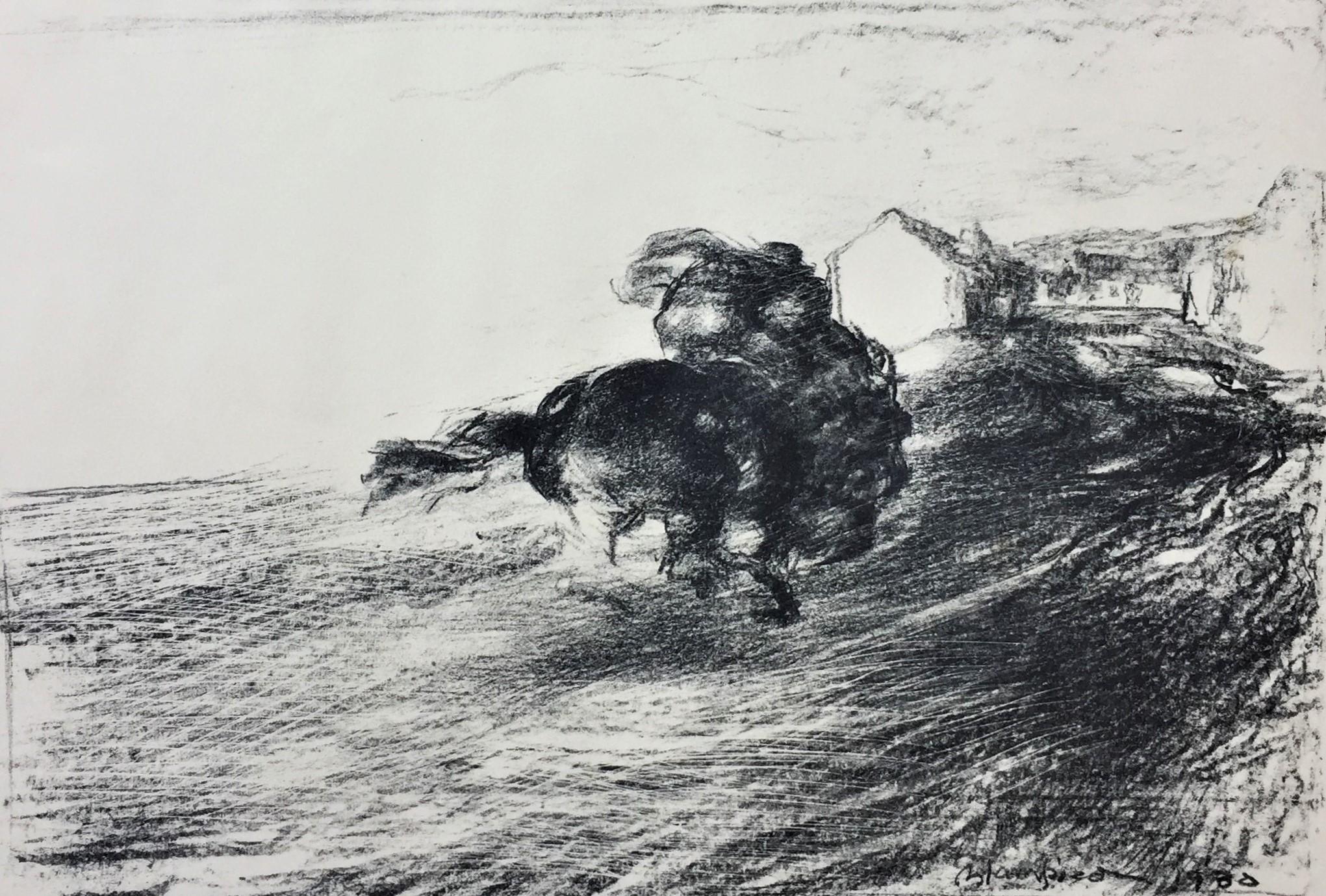Items Similar to George Cronias "Track Pals" Original Color Lithograph C.1960
Want more images or videos?
Request additional images or videos from the seller
1 of 17
George CroniasGeorge Cronias "Track Pals" Original Color Lithograph C.1960Circa 1960
Circa 1960
About the Item
George Cronias (1925-2004) "Track Pals" Original Color Lithograph C.1960
Track pals hanging out on a nice day at Santa Anita
Lithograph dimensions 17.75" wide x 22" high
The frame measures 27" wide x 32" high
This is an "artist proof" lithograph - Pencil signed and titled by the artist
The lithograph is in very good vintage condition
The extreme lower left edge of the mat shows some discoloration (see pics)
- Creator:George Cronias (1925 - 2004)
- Creation Year:Circa 1960
- Dimensions:Height: 32 in (81.28 cm)Width: 27 in (68.58 cm)Depth: 1 in (2.54 cm)
- Medium:
- Period:
- Condition:The lower extreme left edge of the mat shows discoloration.
- Gallery Location:San Francisco, CA
- Reference Number:1stDibs: LU137827145482
About the Seller
4.9
Gold Seller
These expertly vetted sellers are highly rated and consistently exceed customer expectations.
1stDibs seller since 2020
423 sales on 1stDibs
Typical response time: 9 hours
- ShippingRetrieving quote...Ships From: San Francisco, CA
- Return PolicyA return for this item may be initiated within 2 days of delivery.
More From This SellerView All
- 19th Century "Ground Squirrel" Hand Colored Lithograph by T. Doughty C.1830sLocated in San Francisco, CA19th Century "Ground Squirrel" Hand Colored Lithograph by T. Doughty C.1830s From "Nature and on Stone" by T. Doughty The print measures 8.5" wide x ...Category
Early 19th Century Animal Prints
MaterialsLithograph
- Whimsical "Long Legs" Bird With Orange Feathers Signed Lithograph 20th CLocated in San Francisco, CAWhimsical "Long Legs" Bird With Orange Feathers Signed Lithograph 20th C The print is pencil signed and numbered Signed illegibly in the lower right ...Category
Late 20th Century Animal Prints
MaterialsLithograph
- Gould & Richter Reed Warblers LithographBy John Gould and Henry Constantine RichterLocated in San Francisco, CAJohn Gould: 1804-1881. British ornithologist and bird artist. He was the equivalent to the American Audabon. He produced books with lithographed prints such as The Birds of Great Bri...Category
Late 19th Century Animal Prints
MaterialsLithograph
- Gould & Richter Thrush Warbler LithographBy John GouldLocated in San Francisco, CAJohn Gould: 1804-1881. British ornithologist who was the British equivalent of Audobon. He produced these incredible books of The Birds of Great Britain and The Birds of Australia am...Category
Late 19th Century Animal Prints
MaterialsLithograph
- Marcus Elieser Bloch "Sparus Tetracanthus" Framed PrintBy Marcus Elieser BlochLocated in San Francisco, CAMarcus Elieser Bloch "Sparus Tetracanthus" Framed Print 20th c. This fine print is a copy from "Ichtyologie, ou Histoire Naturelle, Generale et Particuliere des Poissons" aka "Ichth...Category
20th Century Animal Prints
MaterialsOffset
- Prideaux John Selby "King Eider" "King Eider, Male & Female" Etching c.1830By John Selby PrideauxLocated in San Francisco, CAPrideaux John Selby "King Eider" "King Eider, Male & Female" Hand Colored Etching C.1830 Plate dimensions 24" wide x 19" high The distressed frame measures 25.75" wide x 20.75" hig...Category
Early 19th Century Animal Prints
MaterialsEtching
You May Also Like
- Ghosts of LithographyLocated in Columbia, MOGhosts of Lithography 2022 Lithograph on BFK 24 x 18.25Category
21st Century and Contemporary Contemporary Figurative Prints
MaterialsLithograph
- Marc Chagall - Couple With a Goat - Original LithographBy Marc ChagallLocated in Collonge Bellerive, Geneve, CHMarc Chagall Original Lithograph Title: Couple With a Goat 1970 Dimensions: 32 x 24 cm From the art revue XXè siècle Reference: Mourlot #608 Unsigned and unumbered as issuedCategory
Mid-20th Century Surrealist Figurative Prints
MaterialsLithograph
- Anubis Mythology God Lithograph Framed Dog Lady Harp In StockBy Michael ParkesLocated in Utrecht, NLAnubis Mythology God Lithograph Framed Dog Lady Harp In Stock - Edition 12/160 Michael Parkes (1944) studied graphic art and painting at the University of K...Category
21st Century and Contemporary Contemporary Animal Prints
MaterialsLithograph
- After Georges Braque - Antiborée - LithographLocated in Collonge Bellerive, Geneve, CHLithograph after Georges Braque. Signed in the plate Edition of 150 Dimensions: 76 x 117 cm Bibliography: « Les Métamorphoses de Braque» of Heger de Loewenfeld and Raphaël de Cuttoli , Editions FAC, Paris, 1989. In 1961 Georges Braque decided with his laidary friend Heger de Loewenfeld to pick up certain of his works to in order to create artworks, this beautiful litograph is one of them. Héméra in the Mythology: In Greek mythology Hemera was the personification of day and one of the Greek primordial deities. She is the goddess of the daytime and, according to Hesiod, the daughter of Erebus and Nyx (the goddess of night). Hemera is remarked upon in Cicero's De Natura Deorum, where it is logically determined that Dies (Hemera) must be a god, if Uranus is a god. The poet Bacchylides states that Nyx and Chronos are the parents, but Hyginus in his preface to the Fabulae mentions Chaos as the mother/father and Nyx as her sister. She was the female counterpart of her brother and consort, Aether (Light), but neither of them figured actively in myth or cult. Hyginus lists their children as Uranus, Gaia, and Thalassa (the primordial sea goddess), while Hesiod only lists Thalassa as their child. The father of Cubism Three Cubist that distinguishes art historian periods were initiated and developed by Georges Braque: The Cubist Cézanne (1907-1909), Executive (1909-1912) and synthetic (1912-1922). Post-Impressionist and fawn, Braque no longer adheres to the contingency of a decorative way or the other. Cézanne’s paintings exhibited at the Grand Palais during the retrospective of 1907 are a revelation: Cézanne sought and invented a pictorial language. In his footsteps, Braque went to the South with the reasons of the Master. He returned with Estaque landscapes and surprising Ciotat it keeps Cezanne geometric model and retains the “passages” continuity from one surface to another to create the sensation of “turning around” of the object represented. But he wants to go after the consequences of the vision of Cezanne. In his paintings Houses in L’Estaque (1908) it simplifies the volumes of houses, neglects detail by removing doors and windows: the plastic rhythm that builds the table. Large Nude , a masterpiece of the period, can be considered the first work of Cézanne cubism . Systematizing and deepening Braque discoveries open the door analytical cubism. In 1909, his painting became more cerebral than sensual. The pattern is recreated in the two-dimensionality of the canvas, leaving aside any illusionistic perspective. In Still Life with Violin, objects are analyzed facets according to their characteristic elements, each facet referring to a particular view of the object. There are so many facets of points selected view: Table reflects the knowledge of the object and the ubiquity of the eye. Moreover, Braque is looking for the essence of the objects in the world rather than their contingency, which explains the absence of light source and use of muted colors (gray, ocher), contingent aspects of the object . But formal logic has stepped facets, erased any anecdote to the object and ultimately led to his painting a hermetic more marked on the edge of abstraction (see the series of Castle Roche-Guyon ). Braque, anxious to keep the concrete and refusing at all costs that the logic of Cubism takes the paintings to abstract, reintroduced signs of reality in his paintings in 1912 marks the beginning of Synthetic Cubism. Historians speak of “signs of real” rather than reality because what interests Braque, this is not to put reality into a table, but to create a painting which, by its language, refers to the real. To do this, he invented two major techniques XX th century inclusions and contributions. The inclusions consist of painting objects that have no real depth, materials (wallpaper in Nature morte aux playing cards faux wood is a pictorial inclusion) or letters (calligraphic inclusion in Portuguese ), made first brush and a few months later stencil. Contributions are defined in contrast with the collage on canvas of foreign materials: glued or sand paper, sawdust, etc.. Regarding the collages, Braque used for the first time in September 1912 a piece of adhesive paper imitating faux wood Compote...Category
1950s Cubist Animal Prints
MaterialsLithograph
- Fetching the Doctor (In Haste for the Doctor)By Edmund BlampiedLocated in Storrs, CTFetching the Doctor (In Haste for the Doctor) 1930. Lithograph. Appleby Lithographs 24. 11 x 16 (sheet 13 3/8 x 18 1/2). Edition 50. Illustration used as a ...Category
Early 20th Century Modern Animal Prints
MaterialsLithograph
- Israeli Modern Passover Lithograph Silkscreen David Sharir Holiday Art SerigraphBy David SharirLocated in Surfside, FLThis is a mixed lithograph and serigraph silkscreen as per descriptions i read. this is not signed or numbered. it is a rare artists or printers proof print. It depicts Moses and Aaron at the top and I believe it relates to Passover and the exodus from Egypt. David Sharir was born in 1938 in Tel Aviv, Israel and currently resides there. David Sharir, the son of Russian immigrants, was born in Israel. Beginning his study of art in Tel Aviv and continuing in Florence and Rome, where he studied architecture and theater design. The brightly colored costumes and intricate stage designs he created for these productions have profoundly influenced his art. When Sharir moved to Jaffa in 1966, his hallmark style was truly developed. Studio, family, and spiritual devotion all serve as inspiration for the imagery in his work. His evolving style combines personal experience, Biblical symbolism, and fantasy. David Sharir, born 1938, Tel Aviv. Was among the first artists to settle in Old Jaffa in 1966. He depicted biblical subjects with a touch of humour and designed sets and costumes for the theatre and opera. Graphic Art in Israel Today Tel Aviv Museum, Tel Aviv 1973 Israel 1948-1958: Watercolors, Drawings, Graphics The Bezalel National Museum, Jerusalem 1958 Jean David, Yosl Bergner, Menachem Shemi, Zvi Mairovich, Ruth Schloss, Nahum Gutman, Moshe Elazar Castel...Category
20th Century Contemporary Figurative Prints
MaterialsLithograph





